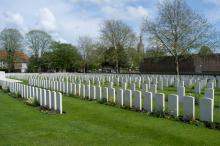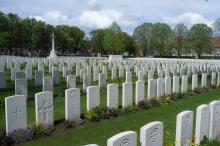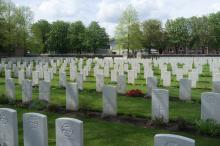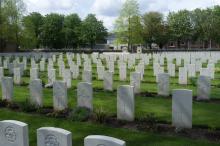Ieper, West-Vlaanderen
The cemetery is located to the North West of Ieper. From the station turn left and drive along M.Fochlaan to the roundabout, turn right and go to the next roundabout. Here turn left into M.Haiglaan and continue for 300 metres and then turn right into M.Plumerlaan. The cemetery is on the right hand side, approximately 200 metres along the road.
From October 1914 to the autumn of 1918, Ypres (now Ieper) was at the centre of a salient held by Commonwealth (and for some months by French) forces. From April 1915, it was bombarded and destroyed more completely than any other town of its size on the Western Front, but even so certain buildings remained distinguishable. The ruins of the cathedral and the cloth hall stood together in the middle of the city, part of the infantry barracks stood in an angle of the south walls and the prison, reservoir and water tower were together at the western gate. Three cemeteries were made near the western gate: two between the prison and the reservoir, both now removed into the third, and the third on the north side of the prison. The third was called at first the "Cemetery North of the Prison," later "Ypres Reservoir North Cemetery, and now Ypres Reservoir Cemetery. This cemetery was begun in October 1915 and used by fighting units and field ambulances until after the Armistice, when it contained 1,099 graves. The cemetery was later enlarged when graves were brought in from smaller cemeteries or from the battlefields of the salient. In Plot V, Row AA, are the graves of 16 officers and men of the 6th Duke of Cornwall's Light Infantry, who were billeted in the vaults of the cathedral and killed on 12 August 1915 by shelling from the "Ypres Express" firing from Houthulst Forest. The survivors were rescued by the 11th King's Liverpools, but these bodies were not recovered until after the Armistice. There are now 2,613 Commonwealth servicemen of the First World War buried or commemorated in the cemetery. 1,034 of the burials are unidentified. The cemetery was designed by Sir Reginald Blomfield.







Add new comment